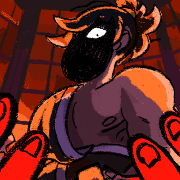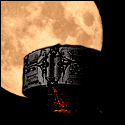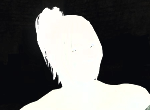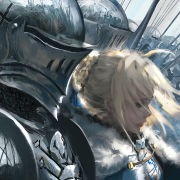|
Nessus posted:It has always astounded me how intensely post-modern these fools are. Their internal beliefs really aren't, though, is the thing. It's just a way to take advantage.
|
|
|
|

|
| # ? May 24, 2024 22:01 |
|
Sartre, among others, noted that the fascist doesn't care when the things he says are ridiculous or incoherent, because the goal is power, not consistency. This is sort of the photonegative of postmodernism, which is all about recognizing and describing the inconsistencies and power relations that underlie the kinds of grand narratives fascism loves. Fascists take their particular grand narrative to a degree of separation from reality that ends up applying skepticism to widely accepted truths - in very specific and limited contexts. A postmodernist might question the cultural narrative built around and by science; a fascist will only ever do that if science opposes his claims. E: what's that one quote about how fascists will ask for tolerance and free speech from their enemies, because their enemies believe in tolerance and freedom- but once they have power, the fascist has no qualms in crushing those same freedoms from their enemies, because at every point all the fascist has believed in is power. Joe Slowboat fucked around with this message at 21:42 on Jun 25, 2019 |
|
|
|
Halloween Jack posted:It's not masochistic, it's sadistic. Since we're decades past the point where who you vote for actually makes a difference in your life, the only joy to be had is in making the other team's fans cry. I’m going to call bullshit on that assertion. Trump’s margin of victory in 2016 was insanely narrow, and there are plenty of people who voted for him or who stayed home who’d be doing better under Clinton, even if Clinton is not and never was some sort of ideal candidate. Joe Slowboat posted:E: what's that one quote about how fascists will ask for tolerance and free speech from their enemies, because their enemies believe in tolerance and freedom- but once they have power, the fascist has no qualms in crushing those same freedoms from their enemies, because at every point all the fascist has believed in is power. Relevant YouTube video: https://youtu.be/5Luu1Beb8ng Insanely relevant, honestly. I keep showing it to people and it keeps answering their precise questions, even when they have multiple, distinct precise questions.
|
|
|
|
Stephenls posted:I’m going to call bullshit on that assertion. Trump’s margin of victory in 2016 was insanely narrow, and there are plenty of people who voted for him or who stayed home who’d be doing better under Clinton, even if Clinton is not and never was some sort of ideal candidate. (More to the point, who I voted for empirically did not make a difference in my life because the electoral college exists. Trump's margin of victory in actual votes wasn't narrow, it was negative.) Joe Slowboat posted:Sartre, among others, noted that the fascist doesn't care when the things he says are ridiculous or incoherent, because the goal is power, not consistency. This is sort of the photonegative of postmodernism, which is all about recognizing and describing the inconsistencies and power relations that underlie the kinds of grand narratives fascism loves. A favourite tactic of the far right is to present their beliefs as comedy, knowing that they ramp it up or laugh it off depending on how they're received. This is how the alt-right infiltrated Internet culture, and how fascists have historically tried to infiltrate music subcultures.
|
|
|
|
Halloween Jack posted:[...] Wait, why am I thinking of "The Producers" right now? Can you elaborate or point to some reading material on that? It sounds very interesting in the "subversion of political elements"-style of things.
|
|
|
|
Mr.Misfit posted:Wait, why am I thinking of "The Producers" right now? It is a distressingly effective strategy because, well, how the gently caress are you going to react to that. Can you really hurt someone who's willing to do that to themselves for their stupid cause? They've got the advantage of being able to say "it's just an act/it's just schtick" or playing the victim. The downsides to this strat is you can't really drop it and if you do it becomes incredibly transparent it was just a costume to wear for a while, and the longer you play the role the more it fucks with you long-term. Though, granted, that downside is the same as immersing yourself in anything for a long period of time,
|
|
|
|
Arivia posted:So your grand assertion is ultimately “5e is easier to learn because it has a combination of general mechanics that I find easy to grasp?” That doesn’t correspond to being easy to learn. That means you have found the mechanics to your liking. If you’d like to elaborate on 5e being specifically well introduced (you might want to compare to the guided play introduction of the mid-90s introductory D&D box set), go ahead. I'm trying to work out whether you simply aren't aware of the actual 2e rules or whether you've just repressed them. 2e is the edition that somehow manages to give distances in exact feet and yards (ranges on the first page of spells include 5 yards/level, 10 yards, and 10 feet) and still doesn't have a grid system. Which means that to actually play 2e by the rules you have to use a tape measure. But it gets worse than having distances in feet and yards without even using a grid system to make that something people can easily know and work out. For that matter it even has opportunity attack rules (DMG page 84 to flee from combat). 2e fireball spell posted:The fireball fills an area equal to its normal spherical volume (roughly 33,000 cubic feet - thirty-three 10' X 10' X 10' cubes). Saying 2e is a theatre of the mind system that doesn't need a grid is like saying 1e is easier and faster than 2e because it doesn't have THAC0 when it has (almost) exactly the same mechanics but forces you to use a lookup table.
|
|
|
|
neonchameleon posted:I'm trying to work out whether you simply aren't aware of the actual 2e rules or whether you've just repressed them. 2e is the edition that somehow manages to give distances in exact feet and yards (ranges on the first page of spells include 5 yards/level, 10 yards, and 10 feet) and still doesn't have a grid system. Which means that to actually play 2e by the rules you have to use a tape measure. But it gets worse than having distances in feet and yards without even using a grid system to make that something people can easily know and work out. For that matter it even has opportunity attack rules (DMG page 84 to flee from combat). None of those references to the 2e rules necessitate a grid, though. They give you measurements in commonly understood units and tell you that you can strike freely at retreating opponents. 5e still discusses everything in terms of 5 foot squares, it just puts the actual note that 5 feet equals a square in a sidebar and marks it optional to pretend that it is otherwise. 5e may not be as grid-dependent as 3e or 4e, but it is still grid dependent. Neither 2e nor 5e is as easy to run as say 13th Age or FATE is in terms of theatre of the mind, but 2e contains no actual references to grid-based combat in the core rulebooks and is written to allow you to run it freely without one. 5e is merely pretending. Using feet and yards may be complicated, and yes you can do better from a complexity standpoint, but comparing the two editions of the D&D rules, solely as provided textually, 2e is the theater of the mind gridless combat RPG that 5e pretends it was.
|
|
|
|
Arivia posted:None of those references to the 2e rules necessitate a grid, though. They give you measurements in commonly understood units and tell you that you can strike freely at retreating opponents. 5e still discusses everything in terms of 5 foot squares, it just puts the actual note that 5 feet equals a square in a sidebar and marks it optional to pretend that it is otherwise. 5e may not be as grid-dependent as 3e or 4e, but it is still grid dependent. Neither 2e nor 5e is as easy to run as say 13th Age or FATE is in terms of theatre of the mind, but 2e contains no actual references to grid-based combat in the core rulebooks and is written to allow you to run it freely without one. 5e is merely pretending. I appreciate 2e breaking your combat roles down into clearly defined categories too which makes it easy for everyone to click as to what they should be doing in a fight. The original holy trinity : 1) Big spell caster that ends the fight 2) Spell Caster Protector 3) Spell Caster Killer Can we talk about 2e encounter design and how fighters having the best saves against everything and the most attacks made them terrifying monsters. EDIT: Also using feet and yards is the absolute worst part of the edition because they are made up fantasy units of measurements that I can't even envision how far they are.
|
|
|
|
Arivia posted:None of those references to the 2e rules necessitate a grid, though. They give you measurements in commonly understood units and tell you that you can strike freely at retreating opponents. 5e still discusses everything in terms of 5 foot squares, it just puts the actual note that 5 feet equals a square in a sidebar and marks it optional to pretend that it is otherwise. 5e may not be as grid-dependent as 3e or 4e, but it is still grid dependent. Neither 2e nor 5e is as easy to run as say 13th Age or FATE is in terms of theatre of the mind, but 2e contains no actual references to grid-based combat in the core rulebooks and is written to allow you to run it freely without one. 5e is merely pretending. 2e is absolutely and categorically position dependent. All a grid is is a simple way of marking position on a map and fast way of dealing with distances. So 2e has actively more complexity regarding the positional rules than 5e - it just does not give you a simple way of handling them. quote:Using feet and yards may be complicated, and yes you can do better from a complexity standpoint, but comparing the two editions of the D&D rules, solely as provided textually, 2e is the theater of the mind gridless combat RPG that 5e pretends it was. On the contrary. Using the actual rules provided 5e is the game of relatively woolly distances and not actively having that much to work out that 2e merely pretended it was by leaving out the simplest way of actively handling those positions while having more intricate positioning rules even than 3.X. When you talk about "solely as provided textually" you are talking about reading the game without actually trying even to use example situations. We're into Pathfinder adventure path levels of "This looks good when read on the loo but doesn't work in play" for 2e's half-assed attempts at theatre of the mind that simply consist of not including rules that would make using the rules the game does present simpler. That said, talking about old saving throws, the TSR ones were better than the WotC ones. Fighters only had the best saves at high level when they needed them - but the saving throws are good. The ones I remember (there were several tweaks) were in order: Save vs death, poison, paralysis/Save vs Rod Staff or Wand/ Save vs Petrification or Polymorph/Save vs Breath Weapon/Save vs Spell or in English Save or die /Save vs Spell in a Can/Save vs lose and survive/Save vs Physical/Save vs Magic One of the tweaks made over time was that paralysis was initially grouped with Petrification and Polymorph as in the character would be out of the fight but could be recovered, but was moved across to the Save or Die category because Hold Person and the like were always and inevitably followed by coup de grace, while people didn't break statues so much and frogs could hop away. One odd thing was that Save vs Spell in a Can was always 1 point easier to save against than save vs spell - but frequently had more of a chance of getting through than the petrification or polymorph save or lose group making for some interesting tweaks in item balancing. I'm not sure how intentional this was. Wizards of course were the best at saving against spells (including spells in a can) and priests the best at saving against death.
|
|
|
|
neonchameleon posted:That said, talking about old saving throws, the TSR ones were better than the WotC ones. Fighters only had the best saves at high level when they needed them - but the saving throws are good. The ones I remember (there were several tweaks) were in order: God can I just talk about how good this system was mechanically. Defining your save type based on the impact it has on you and how it changes the game state and the types of enemies you dealing with is a million times better than pseudo realism categories.
|
|
|
|
kingcom posted:I appreciate 2e breaking your combat roles down into clearly defined categories too which makes it easy for everyone to click as to what they should be doing in a fight.
|
|
|
|
FactsAreUseless posted:A yard's a meter and a foot's a third of that. Can't use this rule to build a house but it's fine for your purposes. Check out this clown shoes feet over here!
|
|
|
|
kingcom posted:Check out this clown shoes feet over here! As someone with feet 12 inches in length: Don't shame
|
|
|
|
Are there any highly tactical RPGs that go with theatre-of-the-mind for positioning? Like, are actually built for it and don't just say 'you don't have to use a grid if you don't want to'?
|
|
|
|
MollyMetroid posted:As someone with feet 12 inches in length: Don't shame I was just calling FAU out, because hes a clown!!
|
|
|
|
Ratoslov posted:Are there any highly tactical RPGs that go with theatre-of-the-mind for positioning? Like, are actually built for it and don't just say 'you don't have to use a grid if you don't want to'? I may be stretching the definition of "Tactical RPG", but The Riddle of Steel would seem to fit the bill. The assumption was that in melee combat you would normally be moving around and circling, so trying to keep a model in a specific square or hex with miniatures isn't all that useful. If you want to press an opponent into bad terrain or hold a doorway, or move so only one opponent can attack you at a time then you have to commit dice from your combat pool to create that effect and your opponent will have to use dice from their pool to roll against you if the want to contest it. https://projects.inklesspen.com/fatal-and-friends/hectorgrey/the-riddle-of-steel/ Edit: If a game like this appeals to you, I should point out that there are three games that borrow heavily for The Riddle of Steel's system that have been developed more recently: Blades of the Iron Throne, Song of Swords, and Sword and Scoundrel. I would not recommend Blades of the Iron Throne; and Song of Swords is definitely the most complicated. Sword and Scoundrel is still in open beta. https://www.drivethrurpg.com/product/264726/Song-of-Swords-Core-Rulebook?src=hottest_filtered https://www.drivethrurpg.com/product/259404/Sword--Scoundrel-Open-Beta-Document?src=hottest_filtered Servetus fucked around with this message at 04:51 on Jun 26, 2019 |
|
|
|
Ratoslov posted:Are there any highly tactical RPGs that go with theatre-of-the-mind for positioning? Like, are actually built for it and don't just say 'you don't have to use a grid if you don't want to'? My first thought is Spellbound Kingdoms, which involves fighting styles built into flowcharts where you move from one maneuver to the next, expend your position on the chart to use powerful techniques, chaining techniques into each other, but in terms of positioning it's basically down to Fate-esque zones.
|
|
|
|
Exalted 3e uses range bands, which are broadly abstract but definitely meant to represent specific distances (since you can be more or fewer range bands from an enemy and this changes your options against them). It does have the theater of the mind pitfall where, since range bands are all distances from other principals, you need to adjudicate character distance from others whom they aren't specifically moving towards and away from, but it's much less galling than 'secretly imagine a grid.'
|
|
|
|
Ratoslov posted:Are there any highly tactical RPGs that go with theatre-of-the-mind for positioning? Like, are actually built for it and don't just say 'you don't have to use a grid if you don't want to'? It's been years and years since I played it so I don't remember everything exactly, but Burning Wheel has a pretty in-depth melee combat system where positioning is "how close you are to your enemy." It doesn't use maps. The tactical choices are the moves you make rather then your environment and where you are, if that counts. There's a combat system for ranged fights too which do take into account if you're fighting from a heavily defended position and whatnot but it still doesn't use a map either.
|
|
|
|
Joe Slowboat posted:Exalted 3e uses range bands, which are broadly abstract but definitely meant to represent specific distances (since you can be more or fewer range bands from an enemy and this changes your options against them). Range bands are poo poo because they turn into mother-may-I as soon as you have three or more discrete groups of characters fighting. It's even more annoying that you can take exactly the same movement rules and use them with Fate-style zones with no other changes.
|
|
|
|
I've found that in practice range bands either don't exist because everyone ends up at Close range from each other, or they effectively become a big grid which everyone moves around on at Speed 1 and can share spaces on.
|
|
|
|
Once again, I'm kind of surprised I haven't seen many TRPGs try to rip off Darkest Dungeons' "line based tactics" system where you position party members in a single file marching order and that determines what maneuvers they can use.
|
|
|
|
Kai Tave posted:Once again, I'm kind of surprised I haven't seen many TRPGs try to rip off Darkest Dungeons' "line based tactics" system where you position party members in a single file marching order and that determines what maneuvers they can use. there's also the model used by old-school CRPGs like Dungeon Master or the Myth Drannor series where you're either in The Front, or At The Back, and that's that. People in the front can only attack the enemies in the front. People at the back can only attack with ranged weapons/effects. And then there are exceptions, such as maybe a polearm that can let a front-liner hit someone in the back, or a back-liner hit from the back.
|
|
|
|
gradenko_2000 posted:there's also the model used by old-school CRPGs like Dungeon Master or the Myth Drannor series where you're either in The Front, or At The Back, and that's that. That's pretty much Darkest Dungeons at a very basic level, except the default party is four characters and there's a greater emphasis on shuffling around mid-combat (with certain characters). For example the Grave Robber class has a dynamic that involves lurking in the back for a while throwing knives before suddenly darting forward to hit something with a pickaxe, except then you have to spend a turn getting her out of the frontlines...unless one of your other party members has a technique that will let them move to the front, etc. The trick, I figure, would be arranging it for a variable number of players since with Darkest Dungeon the designers could count on you at least starting out a run with four characters, even if several of them may not make it back home by the end.
|
|
|
|
Ratoslov posted:Are there any highly tactical RPGs that go with theatre-of-the-mind for positioning? Like, are actually built for it and don't just say 'you don't have to use a grid if you don't want to'? Warhammer Fantasy Roleplay 3e
|
|
|
|
I want to say The One Ring uses Front/Back positioning stuff but it's definitely not highly tactical in the -combat- system.
|
|
|
|
unseenlibrarian posted:I want to say The One Ring uses Front/Back positioning stuff but it's definitely not highly tactical in the -combat- system. Same for Ryuutama. Which I am given to understand is conceptually similar to One Ring in other ways (or maybe the other way around given publication dates, but this is probably just convergent evolution since they’re drawing on pretty much the same sources).
|
|
|
|
kingcom posted:Can we talk about 2e encounter design and how fighters having the best saves against everything and the most attacks made them terrifying monsters. So keeping in mind that 2e uses the 'classic' saves of Paralysis/Poison/Death Magic; Rod/Staff/Wand; Petrify/Polymorph; Breath Weapon; and Spell... And also keeping in mind that the first, fourth, and fifth are by far the most commonly-used, with the first and fifth being the really important ones... And also keeping in mind that LOW IS GOOD because these are target numbers... 1st Level Fighter: 14, 16, 15, 17, 17 1st Level Cleric: 10, 14, 13, 16, 15 1st Level Thief: 13, 14, 12, 16, 15 1st Level Wizard: 14, 11, 13, 15, 12 At 1st level, Fighters are worse at literally everything. So I'll check 7th. Fighter 7: 10, 12, 11, 12, 13 Cleric 7: 7, 11, 10, 13, 12 Thief 7: 12, 12, 11, 15, 13 (thieves get the slowest save progression) Wizard 7: 13, 9, 11, 13, 10 Not much of a difference, there - Fighters are solid middles, and their Spell Save is still not that good. They are slightly better against breath weapons, but that's it. How about 11th. Fighter 11: 7, 9, 8, 8, 10 Cleric 11: 6, 10, 9, 12, 11 Thief 11: 11, 10, 10, 14, 11 Wizard 11: 11, 7, 9, 11, 8 So a Fighter has finally gotten good at stuff by 11th level, but is still largely at parity with Cleric except for breath weapons. And frankly, even then, we're still looking at a And don't get me started on how lame multiple attacks are; 1e/2e literally has quadratic wizards and clerics. Fighters only get 2 attacks per round at level 13, when Wizards are - IIRC - tossing around 6th-level spells, and their 3rd level spells are dealing ridiculous damage. Fighters in 1e/2e were terrible, outside of certain exploits like specialized Dart-Chuckers. (The situation was much improved in BECMI, with weapon mastery, but technically everyone got to come play at the weapon mastery party and it wasn't, like, a Fighter thing so much as a thing they just had better numbers with.) dwarf74 fucked around with this message at 16:11 on Jun 26, 2019 |
|
|
|
If the saves are a Target Number and their TN is 7, isn't that a 70% chance of success, not 35%?
|
|
|
|
edit: brain fart, nvm
|
|
|
|
.
|
|
|
|
In general I would say that a tactical RPG revolves around a system where position is both meaningful and volatile. The error is in assuming that your "position" invariably refers to a spot on a map. So for instance you could probably call Double Cross a tactical RPG despite how in that game position is more about managing your super gauge.
|
|
|
|
Toshimo posted:If the saves are a Target Number and their TN is 7, isn't that a 70% chance of success, not 35%? correct   
|
|
|
|
Toshimo posted:If the saves are a Target Number and their TN is 7, isn't that a 70% chance of success, not 35%?  Nevertheless, a 70% chance of saving vs. instant death is not much better than a 65% chance of saving vs. instant death. Fighters' purported advantage in saving throws is really minor. And still, only a 70% chance for your 11th level character to survive deadly poison is nuts. (In BECMI, dwarves and halflings actually do have noticeably better saving throws than their human counterparts, fwiw. I think elves do too, but I don't recall right off the bat.) dwarf74 fucked around with this message at 16:13 on Jun 26, 2019 |
|
|
|
There are a couple things that made fighters super effective in 2e. 1st - Everyone had to declare what they're doing before initiative is rolled (including magic - "Spells to be cast must also be announced at this time and cannot be changed once the initiative die is rolled.") 2nd - Spell casting time adds to initiative rolls, even if you're not using optional weapon speed rules ( "When a spell's "Casting Time" parameter is given as a number without any units (for example, rounds or turns), then that number is added to the caster's initiative roll to determine his modified initiative." ) 3rd - If a caster is "disturbed" before they have a chance to cast a spell, they lose the spell ("If the spellcasting character is disturbed during this time, the spell is lost.") 4th - Fighter THAC0 improves incredibly quickly compared to equivalent-level caster AC. That's all rules as written, without optional rules that make fighters even more effective. Couple this with multiple attacks in a round, and no real rules for marking, and there are many many situations where a caster isn't going to get a chance to cast a single spell before dying horribly.
|
|
|
|
3:16 Carnage Among the Stars has Ranges, but it's just Close, Near, and Far since the PCs are always a squad fighting a horde of aliens. I never played Tunnels & Trolls, but I understand it innovated the PCs all adding their stats to a big pool and rolling together. Can someone explain how that works? Mr.Misfit posted:Wait, why am I thinking of "The Producers" right now? I can elaborate, though. A popular meme on the alt-right was the idea of "meme magic," that memes were influencing reality. But there was an actual strategy underlying "meme magic": introduce fascism to stuff geeks like by way of memes, then gradually introduce more fascism. Here's a good example:  You don't have to be a Nazi to think mashing up Hitler with Mean Girls is funny, especially if it's 2015 and actual resurgent Nazism isn't on your radar. But there's another version of the same meme that's Hitler standing up in the back of his car and giving the Nazi salute to a rally, and another that's just Nazi soldiers in a half-track. By the end of this process you're "ironically" cheering the SS. The Daily Stormer's style guide is the most open and self-aware explanation of how racists introduce racism into the conversation. They tell their writers to always make racist attacks in a style that can be construed as hyperbolic jokes, and use familiar cultural references. And always, always tie the issue at hand back to the Jewish conspiracy. That's how you get white people who don't even think of themselves as political, but who default to a reactionary defensiveness against feminism, diversity, etc., and pull them into outright fascism. This is also a choice bit: quote:Anything to do with celebrities is going to be interesting to people, because people are interested in celebrities. By adding a Nazi spin, you can do serious damage. We had another major media success when we claimed that Taylor Swift was our "Aryan Goddess" and that we believed her to be a secret Nazi. The media was literally obsessed with this for a news cycle, and was writing articles about how Swift couldn't possibly be a Nazi - and giving actual explanations as to why not. Note: The people working in the media themselves have been indoctrinated with stereotypes about racists being inbred hillbilly retards, so you can make them believe that you believe things you do not actually believe very easily, and they will promote it to try and make fun of you. A particular tactic was to take ordinary, innocuous stuff like the "OK" hand signal, drinking milk, and Taylor Swift and using them to signal fascist affiliation. Of course, these things aren't inherently racist, but the people who turned them into memes were. It was difficult for liberal commenters to point this out without a) showcasing lots of Nazi memes and b) looking like hysterical kooks, which is what the Nazis wanted. The r/frenworld phase of the alt-right is even more strange to me, because it appears they've thrown out the subtext completely. It's literally "Here's Nazis, but in clown costumes, so how can you get mad at this?" Halloween Jack fucked around with this message at 17:09 on Jun 26, 2019 |
|
|
|
dwarf74 posted:It's oversold, by a lot. Fighters don't have really exceptional saving throws at all, and the multiple attacks are senseless compared to actual quadratic wizardry. For comparison, OD&D: 0-7,999 XP: Fighter (1-3): 12-13-14-15-16 Cleric (1-4): 11-12-14-16-15 Magic-User (1-3): 13-14-13-16-15 8,000-11,999 XP: Fighter (4): 10-11-12-13-14 Cleric (4): 11-12-14-16-15 Magic-User (3-4): 13-14-13-16-15 12,000-34,999 XP: Fighter (4-6): 10-11-12-13-14 Cleric (5-6): 9-10-12-14-12 Magic-User (4-5): 13-14-13-16-15 35,000-63,999 XP: Fighter (6): 10-11-12-13-14 Cleric (6-7): 9-10-12-14-12 Magic-User (6-7): 11-12-11-14-12 64,000-199,000 XP: Fighter (7-8): 8-9-10-10-12 Cleric (7-8): 9-10-12-14-12 Magic-User (7-9): 11-12-11-14-12 200,000-299,999 XP Fighter (8-9): 8-9-10-10-12 Cleric (9): 6-7-9-11-9 Magic-User (10): 11-12-11-14-12 300,000-479,999 XP Fighter (9): 8-9-10-10-12 Cleric (10-11): 6-7-9-11-9 Magic-User (11): 8-9-8-11-8 480,000-599,999 XP Fighter (10): 6-7-8-8-10 Cleric (11-12): 6-7-9-11-9 Magic-User (11): 8-9-8-11-8 600,000-1,199,999 XP Fighter (10-12): 6-7-8-8-8-10 Cleric (13-18): 3-5-7-8-7 Magic-User (12-13): 8-9-8-11-8 1,200,000-1,799,999 XP Fighter (13-15): 4-5-5-5-8 Cleric (19-24): 3-5-7-8-7 Magic-User (14-15): 8-9-8-11-8 1,800,000+ XP Fighter (15+): 4-5-5-5-8 Cleric (25+): 3-5-7-8-7 Magic-User (16+): 5-6-5-8-3 Though note that a) this is inaccurate because XP gain varies by level and therefore by class, and b) because Gygax in his infinite glory gave no guidance on how to extend the experience tables beyond ~8 levels, not everyone would have played with the above XP progression, which was the one Gygax' table used. Broadly, Clerics have the best saves, while both Fighters and Clerics quickly pull ahead of Magic-Users because of the latter's doubly slow progression.
|
|
|
|
Halloween Jack posted:I never played Tunnels & Trolls, but I understand it innovated the PCs all adding their stats to a big pool and rolling together. Can someone explain how that works? The player rolls a number of dice as determined by their weapon, and then they add a +1 to this result for every point of Strength, Luck, and Dexterity over 12. So a player with a Great Sword and 14 Strength, 13 Luck, and 15 Dexterity would roll [6d6+2+1+3] All the players engaging in melee combat would do this, and their results would be added to a grand total. ___ Every monster has a Monster Rating, where a Goblin might have an MR of 30, while a Dragon might have an MR of 110. They would roll as many d6's as their [MR / 10], and then they would add half their MR to this result for the first round of combat, or quarter of their MR on all subsequent rounds. So a Goblin with an MR of 30 would roll [3d6+15] during the first round of combat, and [3d6+7] on all subsequent rounds All the monsters engaging in melee combat would do this, and their results would be added to a grand total. ___ Then, you'd compare the two grand totals, and subtract the smaller result from the larger result. If the players had the larger result, then the difference is subtracted from a monster's MR If the monsters had the larger result, then the difference is subtracted from the player's Constitution Notably, armor is "ablative", taking hits before your Constitution does, though it's not clear how often this regenerates. ___ Example: if you had two players, both wielding Great Swords and having 14 Strength, 13 Luck, 15 Dexterity, and 10 Constitution, and they were fighting two Goblins, with 30 MR each. The first player rolls and gets a 24. The second player rolls and also gets a 24, resulting in a 48 total. The goblins roll [6d6+30] and get a 51. 51 is greater than 48, so the monsters win, and the first player takes 3 damage, reducing their 10 Constitution to 7 (assuming they were unarmored). The players roll again. Summing their rolls together into a single [12d6+12], we get a total of 66 in this second round. The goblins roll [6d6+14] since it's now round two and the flat modifier is reduced to a quarter of their MR. They get a 29. 66 minus 29 is 37, which is enough to kill one Goblin entirely (30 MR), and leave the second Goblin at 23 MR The players roll again. They get a total of 56 The remaining Goblin rolls [2d6+5], since they're only at 23 MR now. They get a total of 12. 56 minus 12 is 44, which then kills the second Goblin also. The players win this combat. Actually, I'm not sure if the MR adjusts in real-time against partially-hurt monsters, but it wouldn't have made a difference. ___ This does not yet cover ranged combat, which is a different system.
|
|
|
|

|
| # ? May 24, 2024 22:01 |
|
Thanks for the explanation! That seems like a lot of rolling and adding up to do. I assume T&T doesn't do the AD&D1e thing where you can regularly have encounters with dozens of weak enemies; that would really drag out. The Darkest Dungeon references threw me for a loop because I assumed people meant the game that was spun off of Dark Dungeons, the BECMI retroclone. Darkest Dungeon combat looks similar to Final Fantasy Tactics/Ogre Battle style combat. Are there roleplaying games that do those front rank/back rank mechanics?
|
|
|
































